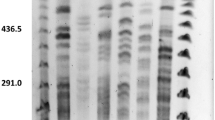Abstract
A total of 31Campylobacter strains were studied. Of these, 24 were thermotolerant field isolates and 7 were reference strains. Mol% G+C was estimated by thermal denaturation and DNA-DNA-relatedness by the hydroxyapatite method. The strains identified asC. jejuni orC. coli and differentiated by the hippurate hydrolysis test formed separate, homogenous DNA homology groups. The two species were genetically more related to each other than to otherCampylobacter species. Results also show that the group of hippurate-negative thermotolerant campylobacters resistant to nalidixic acid is genetically heterogenous.
Similar content being viewed by others
Literature Cited
Grimont, P. A. D., Popoff, M. Y., Grimont, F., Coynault, C., Lemelin, M. 1980. Reproducibility and correlation study of three deoxyribonucleic acid hybridization procedures. Current Microbiology4:325–330.
Harvey, S. M. 1980. Hippurate hydrolysis byCampylobacter fetus. Journal of Clinical Microbiology11:435–437.
Lapage, S. P. 1974. Practical aspects of probabilistic identification of bacteria. International Journal of Systematic Bacteriology24:500–507.
Leaper, S., Owen, R. J. 1981. Identification of catalase-producingCampylobacter species based on biochemical characteristics and on cellular fatty acid composition. Current Microbiology6:31–35.
Owen, R. J., Leaper, S. 1981. Base composition, size and nucleotide sequence similarities of genome deoxyribonucleic acids from species of the genusCampylobacter. FEMS Microbiology Letters12:395–400.
Sandstedt, K., Ursing, J., Walder, M.. ThermotolerantCampylobacter with no or weak catalase activity isolated from dogs. Current Microbiology8:209–213.
Skirrow, M. B., Benjamin, J. 1980. ‘1001’ campylobacters: cultural characteristics of intestinal campylobacters from man and animals. Journal of Hygiene85:427–442.
Skirrow, M. B., Benjamin, J. 1980. Differentiation of enteropathogenicCampylobacter. Journal of Clinical Pathology33:1122.
Smibert, R. M. 1978. The genusCampylobacter. Annual Review of Microbiology32:673–709.
Véron, M., Chatelain, R. 1973. Taxonomic study of the genusCampylobacter Sebald and Véron and designation of the neotype strain for the type speciesCampylobacter fetus (Smith and Taylor) Sebald and Véron. International Journal of Systematic Bacteriology23:122–134.
Walder, M., Sandstedt, K., Ursing, J.. Phenotypic characteristics of thermotolerantCampylobacter from human and animal sources. Current Microbiology8:307–310.
Author information
Authors and Affiliations
Rights and permissions
About this article
Cite this article
Ursing, J., Walder, M. & Sandstedt, K. Base composition and sequence homology of deoxyribonucleic acid of thermotolerantCampylobacter from human and animal sources. Current Microbiology 8, 307–310 (1983). https://doi.org/10.1007/BF01577733
Issue Date:
DOI: https://doi.org/10.1007/BF01577733




